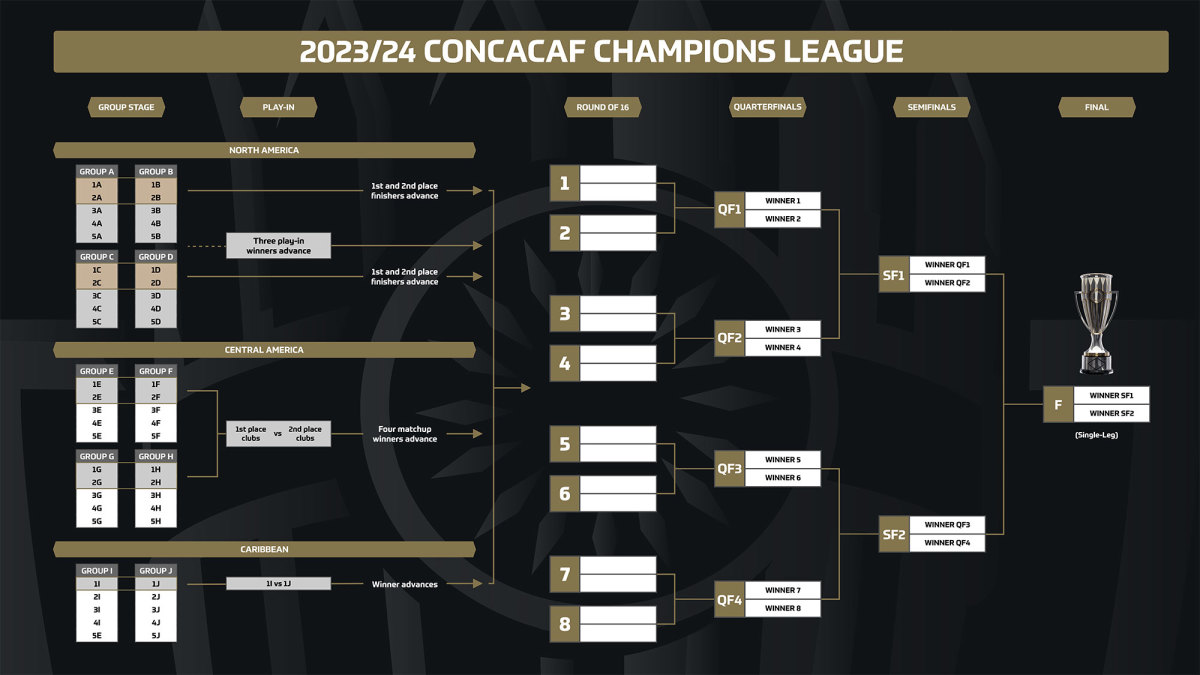Concacaf Reveals Champions League Expansion, New Format Starting in Fall 2023

Concacaf on Thursday afternoon confirmed a dramatic expansion and overhaul of its club competition format starting in the fall of 2023, when 10 regionalized groups of five teams each—including four groups comprising teams from the USA, Canada and Mexico—will kick off a new year-long tournament to crown the confederation champion.
“This is a hugely important development for Concacaf and for club football in our region,” Concacaf president Victor Montagliani said in a written statement. “The Concacaf Champions League has grown impressively in recent years, but this new format will transform the competition and significantly increase its relevance throughout our confederation and globally.”
Concacaf staged a year-long tournament featuring a group stage in 2008-16, but it failed to establish much traction as Liga MX and, eventually, MLS clubs faced little opposition. Meanwhile, individual matchups beyond the USA-Mexico rivalry typically lacked appeal in Concacaf’s most important markets. So since 2018, the CCL has been a brief, bracketed competition supported by the Concacaf League qualifiers for clubs from Central America and the Caribbean.

In fall 2023, the CCL will revert to a classic Champions League format, with a significant increase in the number of entrants and matches, but with groups limited to teams from North America, Central America or the Caribbean, respectively. The idea is to guarantee rivalry and parity from the start, while respecting each zone’s relative strength. The 16-team knockout stage will be played each spring, with 11 berths reserved for North American sides, four for Central American teams and one for the Caribbean.
On a call with reporters, Montagliani said there was quick buy-in from MLS and Liga MX despite potential schedule congestion and their interest in supporting their own competitions.
"They've had tremendous growth over the last 25 years, but they need to make it to the next stage," he said of MLS. "The next stage for them is international relevancy, and that's going to be done through the Champions League."
Concacaf didn’t announce how many entries will be granted to individual countries, and representation could vary each season. In addition to a North American group stage berth reserved for the winner of the Leagues Cup, the new knockout competition organized by MLS and Liga MX, analogous regional cup competitions will be created in Central America and the Caribbean. The Concacaf League will cease following the 2022 edition.
Here’s a brief look at how the new tournament will work:
North America - Four groups of five teams each, comprised of teams from USA, Canada and Mexico. The Leagues Cup winner will be guaranteed entry. Each team will play four group-stage games, two home and two away, and the top two finishers in each group will automatically advance to the round of 16. Wild cards then will contest a playoff to furnish three more teams for the knockout stage.
Montagliani said that Canada will be guaranteed at least three entries, with the remaining 17 coming from MLS and Liga MX. The exact qualification mechanisms haven't been determined, but the U.S. Open Cup champion will continue to earn a bid, he confirmed. Among the three Canadian berths, two will be determined by Canadian Premier League results and one by the annual Canadian Championship. Unlike now, Canadian clubs also will be able to qualify via MLS–so if one Canadian MLS club wins the Canadian Championship and one or two others meet MLS criteria, Canada would secure more than 3 CCL spots.
Although the Leagues Cup winner will earn a CCL berth, Montagliani said Concacaf wouldn't interfere with the qualification criteria. It remains an MLS/Liga MX property, and they'll decide who plays in it.
"We've actually empowered the Leagues Cup," Montagliani said.
Despite its size and the lack of promotion and relegation in the USA, the USL Championship still will be considered a second-division league and won't have direct access to the CCL. Its only chance to compete will be to win the U.S. Open Cup. However, Montagliani said that Concacaf already is starting to consider "the next level of competition" and how it might include leagues like the USL Championship in the future.
Central America - Four groups of five teams each will be arranged for clubs from the seven Central American countries. Domestic results and the new regional cup competition will determine the entrants. After each club plays four games, the top two finishers in each group will enter a playoff round, from which the four winners will move on to the CCL’s round of 16.
Caribbean - Two groups of five teams each, which will be determined by domestic results and the new regional cup competition, will produce two first-place teams that will face off for the Caribbean’s single spot in the round of 16.
“Further detail on the numbers of clubs which will qualify for the new Concacaf Champions League through specific league and cup competitions will be communicated by in due course,” Concacaf said Thursday.
Montagliani also said he is uncertain about when FIFA's expanded Club World Cup will begin. The assumption is that Concacaf will have three berths, but the CWC's frequency and how those berths will be determined have yet to be finalized.
